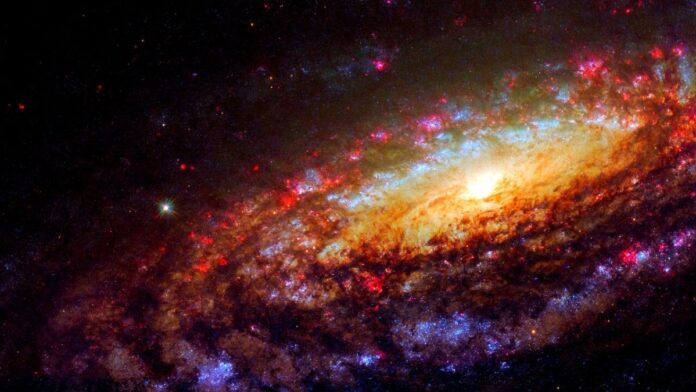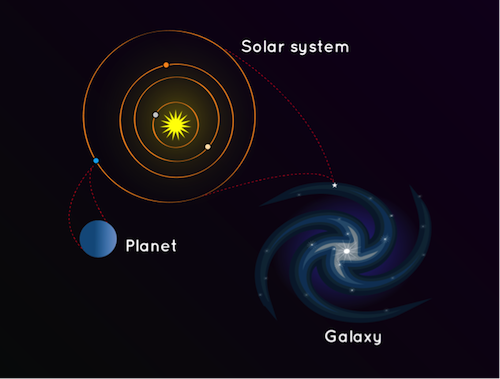
A galaxy is a gravitational boundary of stars, stellar residues, interstellar gases, dust, and dark matter. The word galaxy in English is derived from the Greek galaxy (ξίαλαςα), which means “milky,” a reference to the Milky Way. While in India, the word galaxy is derived from Sanskrit, which is mentioned in our archeological texts. Galaxies range in size from dwarfs to a few hundred million (108) stars, with one hundred trillion (1014) stars, each vortex orbiting the center of its Galaxy.
Contents
What is Galaxy?
“A galaxy is a vast collection of gas, dust, and billions of stars and their solar systems, all held together by gravity. A galaxy holds them altogether due to massive gravity.”
We live on a planet called Earth which is part of our solar system. But where is our solar system? It is a small part of the Milky Way Galaxy, and in the middle of our Milky Way, the Milky Way is also a supermassive black hole that binds everyone together by its massive gravity.

Our Milky way galaxy
Our Milky Way is called Kshiramarga or Mandakini or Milky Way in English, where the Earth and our solar system are located. Our Galaxy is a spiral shape, with a large center and several curved arms emanating from it. Our solar system is located on its Orion-Cygnus Arm. Our Galaxy has between 100 billion and 400 billion stars. It is estimated that there will be about 50 billion planets, 500 million of which are far from their stars to keep life-worthy temperatures. However, a survey in 2011 found the possibility that there could be more planets than this estimate – according to this study, the Galaxy may have twice the number of stars. Our solar system is located on the outskirts of the Galaxy and is orbiting the center of the Galaxy. It takes about 22.5 to 25 million years to do a complete orbit.
Galaxy word, name, and history
Galaxy word
In Sanskrit and many other Indo-Aryan languages, our Galaxy has been called the “Milky Way.” In the Puranas, the Milky Way and the Ganga River on Earth are considered to be a pair of each other, and both are considered sacred. In ancient Hindu texts, the Milky Way has been called “Kshir” (i.e., milk). Even outside the Indian subcontinent, many civilizations found the Milky Way milky. The word “galaxy” originates from the Greek word “gala” (γάλα), which also means milk. Persian is an Indo-Iranian language similar to Sanskrit, so its word for “milk” is homogeneous “sheer,” identical to Sanskrit “kshir,” and the Milky Way is called “rah-e-sheeri.” In English, the Milky Way is called the “Milky Way,” which also means “Milk Way.”
Some East Asian civilizations saw a river in the Milky Way, like the word “Milky Way.” The Galaxy is called “silver river” in Chinese and also “mirinae” (i.e., “silver river”) in Korean.
The word “galaxy” was derived from the Greek word for France and medieval Latin. In the astronomical literature, the capital term “galaxy” has often been used to refer to our Milky Way, the Milky Way, to distinguish it from other galaxies in our universe. The English word Milky Way can also be traced to a story by Chaucer c.
Galaxy names
Thousands of galaxies have been listed, but only a few have well-established names, such as the Andromeda Galaxy, the Magellanic Clouds, the Whirlpool Galaxy, and the Sombrero Galaxy. Astronomers work with numbers from some catalogs, such as the Messier catalog, NGC (New General Catalog), IC (index catalog), CGCG (list of galaxies and groups of galaxies), MCG (morphological catalog of galaxies), and UGC ( Uppala General Catalog of Galaxies). All famous galaxies appear in one or more chronicles, each time under a different number. For example, Messier 109 is a spiral galaxy, number 109 in Messier’s catalog, and also has NGC 3992, UGC 6937, CGCG 269-023, MCG + 09-20-044, and PGC 37617.
Discovery of galaxies
The galaxies were initially discovered by binoculars and known as the spiral nebula. Most 18th- to 19th-century astronomers considered them unresolved star clusters or angelic nebulae and were considered part of the Milky Way. Still, their exact composition and nuances remained a mystery. Finally, observations using large telescopes of nearby bright galaxies, like the Andromeda Galaxy, began to resolve them into vast clusters of stars. However, based on apparent unconsciousness and a growing population of stars, the actual distances of these objects placed them ahead of the Milky. Way. For this reason, they were popularly called island cosmos, but the term did not quickly come into use, as the term cosmos implied the entirety of existence. Instead, they are referred to as galaxies.
History of galaxies
In ancient history, many ancient Indian and Greek astronomers like Lagadha, Aryabhatta, Bhaskara, Varahamihira, Brahmagupta, Aristotle, and Democritus, proposed concepts of the Galaxy and the “Milky way.” After then, Arabian astronomer Alhazen, Persian astronomer al-Bīrūnī, Andalusian astronomer Ibn Bâjjah, and Syrian-born Ibn Qayyim gave their observation and views on the Galaxy and Milky Way.
But the objective evidence of the Milky Way was coined in 1610 when Italian astronomer Galileo Galilei used a telescope to study the Milky Way, which showed him that it was made up of many weak stars. Then, in 1750, the English astronomer Thomas Wright hypothesized that in one of his core theories or new hypotheses of the universe, the Milky Way could be a rotating body of vast numbers of stars, joined together by the force of gravity, just like our solar system, but on a much larger scale. The resulting discs of the stars can be seen as a band in the sky from our point of view inside the disc. In a treatise in 1755, Emmanuel Kant elaborated on Wright’s idea of the structure of the Milky Way.
Sources
- Akashaganga, Ākāśagaṅgā, Ākāsagaṅgā, Akasha-Ganga, Akasaganga: Seven definitions of Akashaganga – Wisdom Library
- Sparke, L. S.; Gallagher III, J. S. (2000). Galaxies in the Universe: An Introduction. Cambridge University Press. ISBN978-0-521-59740-1.
- Paul, E. R. (1993). The Milky Way Galaxy and Statistical Cosmology, 1890–1924. Cambridge University Press. ISBN978-0-521-35363-2.
- Belkora, L. (2003). Minding the Heavens: the Story of our Discovery of the Milky Way. CRC Press. ISBN 978-0-7503-0730-7.
- Bertin, G.; Lin, C.-C. (1996). Spiral Structure in Galaxies: a Density Wave Theory. MIT Press. ISBN 978-0-262-02396-2.
- Binney, J.; Merrifield, M. (1998). Galactic Astronomy. Princeton University Press. ISBN 978-0-691-00402-0. OCLC 39108765.
FACT CHECK: We strive for accuracy and fairness. But if you see something that doesn’t look right, please Contact us.
DISCLOSURE: This Article may contain affiliate links and Sponsored ads, to know more please read our Privacy Policy.
Stay Updated: Follow our WhatsApp Channel and Telegram Channel.












Best view I have ever seen!